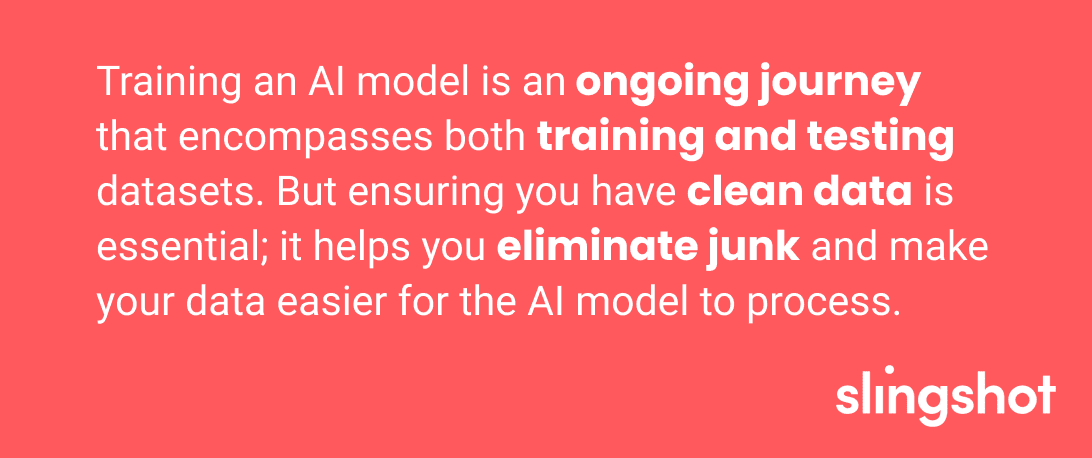If you saw our blog Artificial Intelligence’s Impact on Development Models, you know how AI could impact each phase of the development process. Congrats! ?
But now you need to set some ground rules for implementing it. Good news: this blog will do that! These best practices can help you tap into the full power of AI, boosting your efficiency, accuracy, and innovation game.
Summary
- Begin your AI journey by identifying the problem and ensuring its suitability for AI solutions.
- Model selection is a critical decision based on the data’s nature, problem complexity, and resources available.
- Quality training and testing data are essential for AI model success, emphasizing the significance of data cleanliness.
- Interpretability and explainability in AI are crucial for building trust and ensuring regulation compliance.
- Effective collaboration and communication among developers, data scientists, and domain experts are key to AI project success.
Identify the Problem:
Before you start figuring out what problem you’re trying to solve with AI, you need to decide if your issue is solvable with AI. A good-for-AI problem has three key factors: tractability, data availability, and problem formulation. Is this even a problem that can be solved? Is there enough historical data to train the AI algorithm? Can we find a solution within a reasonable scope?
If all your answers to those questions are yes, you’re ready to nail down the ‘what.’ Once you have a clear vision of what you need and what success looks like for your AI project, you can strategize how AI can help you achieve these goals. This initial step is essential because it ensures everyone is on the same page, working toward a common objective and establishing a solid foundation for a successful AI project.
Model Selection:
This decision carries considerable weight and relies on various factors, including the nature of your data, the complexity of the problem, and the available computing resources. Take your time with this step and explore different models and algorithms until you discover the one that aligns best with your specific problem. You may find an existing algorithm that aligns well with your needs. Making the right choice here can have a profound impact on the performance of your AI system.
Amazon SageMaker provides a rich array of built-in algorithms, pre-trained models, and pre-built solution templates to streamline the process of training and deploying machine learning models. This toolkit is a game-changer for data scientists and machine learning practitioners, whether seasoned experts or newcomers to SageMaker. You can check out some real-world examples on their developer page.
Training and Testing:
The quality of data training AI models is the cornerstone of success. While having the data available is obviously important, you’ll also have to make sure that it’s high-quality and free of inconsistencies and noise. That’s where data cleaning and preprocessing come in: they help you eliminate all the junk and make your data spotless for your AI model. Remember, the output of your AI system will only be as good as the input data: garbage in, garbage out, and all that. So focus on data quality: invest the time and effort to ensure your data is clean. Trust us; it’ll pay off in the long run!
Training an AI model is an ongoing journey that encompasses both training and testing datasets, allowing us to delve into the fascinating realms of supervised and unsupervised learning. In the supervised paradigm, the algorithm learns from labeled input and output training data, enabling it to grasp the relationship between the two and refine itself to predict outcomes accurately for new, unseen data. Nevertheless, the creation of labeled training data can be resource-intensive. On the flip side, unsupervised learning operates with unlabeled, raw data, revealing hidden patterns and intrinsic relationships within the dataset. This technique is a powerful tool for uncovering trends without needing pre-labeled information, making it an invaluable approach in AI model development.
The importance of testing datasets comes to the forefront, as they provide an objective measure of how well your AI model generalizes to real-world situations. This ongoing process of model training, testing, and refinement is crucial to achieving a high-performing, unbiased, and problem-solving AI system. So, whether you’re in the realm of supervised or unsupervised learning, the synergy of quality training and testing data remains essential for AI success.

Interpretability and Explainability:
Transparency is a critical aspect of AI implementation. If the AI’s decisions impact stakeholders or assist with significant choices, it’s especially crucial to explain how it’s reaching conclusions. This helps build trust and makes it easier for users to understand and believe in the system. Plus, transparent AI models help you stay compliant with regulations and ethical considerations, which is super important if you want to use AI responsibly.
In the AWS ecosystem, Amazon SageMaker Clarify employs Shapley values to enhance interpretability. This empowers business leaders with insights, aligns AI with their objectives, and fosters transparency. In the ever-evolving AI landscape, interpretability and explainability are essential for harnessing AI’s potential, ensuring trust, and alignment with business goals.
Ethical Considerations:
It’s crucial to address ethical considerations when working with AI. Ensuring that your AI is fair, transparent, and secure is paramount. While testing or using your AI, it’s essential to look for any biases that may arise (whether intentional or not) and address them promptly. Being ethical is not just a moral obligation, but it is also a practical necessity as it helps build trust and credibility among users. Moreover, it helps protect you from legal or reputational damage that may arise from any unethical practices. Therefore, it’s essential to prioritize ethical considerations when building and deploying AI systems.
Security and Robustness:
AI systems are not immune to security threats and unexpected scenarios, and their unique characteristics demand a specialized approach to safeguarding them. It’s of utmost importance to maintain a rigorous focus on data protection, ensuring that you are well-versed in the precise location and handling of the data used by your AI model. If open-source technologies are part of your AI stack, carefully assess their compatibility with your business requirements, and in sectors like healthcare, prioritize HIPAA compliance to protect sensitive data.

Monitoring, Maintenance, and Metrics:
Once you’ve got your AI tools up and running, the job still needs to be done. Monitoring the performance of your AI tools after release is paramount. This helps you track their performance and identify anomalies or deviations from the expected behavior. Continuous monitoring lets you catch any issues early, preventing potential disruptions and maintaining optimal performance.
But it’s not just watching out; you need action. AI systems, like any technology, require regular maintenance and updates to adapt to evolving needs and challenges. As the business landscape changes, your AI models should evolve in tandem to stay relevant and practical. Frequent updates and fine-tuning are essential to ensure that your AI system continues to meet user requirements and remains a valuable asset.
Last and most importantly: metrics. They’re the compass by which you navigate the AI landscape. Establishing key performance indicators (AKA KPIs) and metrics helps you measure the impact and effectiveness of your AI tools. For instance, if you’re replacing a manual process, metrics allow you to compare the new AI-powered workflow’s performance against the previous manual process, determining whether it meets or exceeds predefined benchmarks. Metrics also provide valuable insights for making data-driven adjustments and improvements.
Collaboration and Communication:
This may be the most important tip: when it comes to making AI work, it’s all about teamwork. You need your developers, data scientists, and domain experts on the same page, working together like a well-oiled machine. And that means, as cheesy as it is, communication is vital. You want to make sure everyone knows what the goals are, what the challenges might be, and how they can all contribute to the project’s success. The magic happens when everyone is sharing their knowledge and collaborating effectively, and you can deliver some genuinely impactful AI solutions.
Conclusion
If you want to bring AI into your development team, it’s important first to figure out exactly what problem you’re trying to solve – make sure everyone understands the goal. Trust us, quality data and picking the best model are super crucial for getting the best results. Keep training your system, be transparent about how it works, and always be mindful of ethics.
And last but not least, make sure everyone is talking to each other and working together! Keep an eye on your system’s performance, too – things can change quickly in this field.
And there you have it: the best practices for implementing AI in your dev teams! Now, you’re better equipped to efficiently and effectively bring this expanding tech into your work. Now, if only it could attend meetings for us… ?




